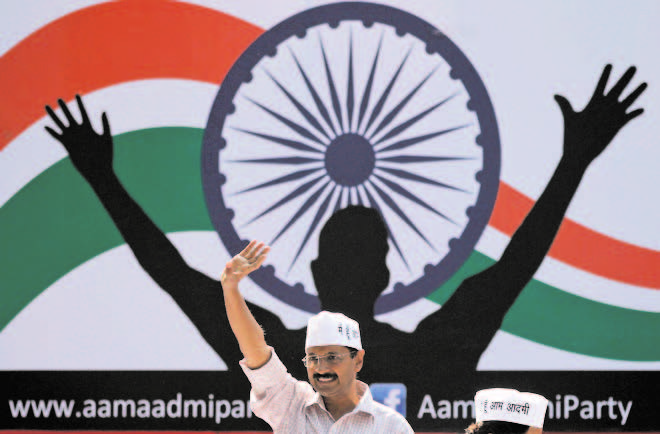
Political scientists write with some regret of how a political movement that had tapped the consciousness of lakhs of Indians through sustained and patient mobilization, dissemination of ideology, and shared understanding of what is wrong with our society and what can be done about it atrophied and folded up when it began to rule. The empirical referent is, of course, the Indian National Congress. In the 1970s, the once charismatic and sage leadership of the Congress reduced itself into a bunch of courtiers paying ritualized homage to the leader. In the second decade of the 21st century, India witnessed a contrary phenomenon. A civil society movement against corruption mutated into a political party, and in two consecutive years formed a government in Delhi. The victory of the party showed a mirror to established political parties that increasingly rely on the supposed charisma of one man or woman to win elections.
Meteoric rise and meltdown
The Aam Aadmi Party’s (AAP) strategies of connecting with citizens, particularly in the slums of Delhi, put into practice the wisdom of democratic theory: that the task of a party is to arouse political awareness by means other than the dishonorable politics of identity, evoke critical evaluations of power and its misuse, and enable the articulation of everyday needs and aspirations. This sagacity was confirmed the moment the AAP won power in the 2013 and 2014 Assembly elections.
Even within the limited power that Delhi, not quite a Union Territory but not wholly a State, has been granted, the hope was that the AAP, backed by a massive majority, would perform. The party, however, failed to shrug off the techniques that had brought it fame in its civil society avatar, the politics of accusation, ‘naming and shaming’, and blame, and become a party that concentrates on democratic governance. Arvind Kejriwal‘s government has not been allowed to perform, Ministers have been harassed by the police, the Lieutenant Governor has performed a role normally reserved for a Viceroy, and the Opposition, reduced to a pathetic rump in the 2014 elections, has sponsored a number of sting operations and complaints against Ministers.
But all is not well in the quintessential anti-establishment party. For one, the AAP has failed to priorities a clearly enunciated and well-thought-out belief system that all members can subscribe to, and that distinguishes the party from others. Two, it has developed a leadership cult, and such cults hardly tolerate dissent. Three, this has occurred because the party has failed to establish mechanisms for reconciling difference of opinion among members.
The AAP should learn from history, for example from the Congress system in the 1950s and early 1960s. Intricate networks to resolve conflict between political interests represented in the Congress ensured that no one interest gained or lost too much. Because the AAP has not established such procedures, we witness the ignominious spectacle of leaders exiting the party in a huff and blasting the dictatorial tendencies of Mr. Kejriwal.
Delhi rerun in Punjab?
The same political spectacle is now being re-enacted in Punjab in the run-up to the 2017 State elections. Earlier this year, the AAP effectively challenged the monopoly on political power exercised by the Shiromani Akali Dal-Bharatiya Janata Party (SAD-BJP) alliance on the one hand, and the Congress on the other. Mr. Kejriwal appeared on to the political horizons of Punjab as a swashbuckling Roman gladiator, and metaphorically girded his loins to cure the twin malaise of misgovernance and deprivation in the State. Reeling under two terms of the SAD-BJP alliance, the people of Punjab breathed, or so initial surveys held, a sigh of relief. At last someone who does not carry the historical burdens of Punjab on his shoulders has come to rescue people from non-performing Punjabi politicians.
Hundreds of volunteers flocked to the party and enabled the leaders to establish contact with the debt-ridden peasantry, and hold dialogues with vulnerable sections to identify the components of the Punjab crisis: serious agrarian distress that has led to farmer suicides, the drug menace, the ominous influence of the liquor and the sand mafias, the lack of access to health and education, acute unemployment, and above all, the completely amoral corruption of those who have ruled and continue to rule Punjab.
The contact program of the AAP should have made it aware of the scale of the calamities that have hit Punjab since the 1980s. But it is precisely here that the party falters and shows neither initiative nor imagination. Unveiling the AAP’s ‘Farmers and Farm Laborers Manifesto’ on September 11 at Baghapurana village near Moga, Mr. Kejriwal upped his allegations against Ministers belonging to SAD and Congress leaders and promised them jail if voted into power.
Certainly corruption is a critical issue that stalks high economics and politics as well as everyday life in India. The issue, however, hardly forms the stuff of which an inspired and visionary party manifesto is authored and drafted. Destruction of corruption through administrative means should be an essential precondition for democracy. In India, the ignoble phenomenon has become a surrogate for democracy; an alibi for authoritarian proclivities. In the process, politics has been reduced to management. And a politically imaginative and innovative vision of how complex problems can be resolved has been diminished to populism.
Populist politics
It is precisely in these spheres that the AAP has been unable to transcend its origins as an anti-corruption movement. Mr. Kejriwal heaps abuse on politicians deemed to be corrupt and threatens them with imprisonment. What are his solutions to the other problems of the State? Re-enacting the well-worn script of political agendas in Punjab, he promised the status of a holy city to Amritsar and Anandpur Sahib, easing of debts, waiver of bank loans to poor farmers, laborers, Scheduled Castes and Backward Castes, a halt on action by banks against defaulters till the end of 2018, compensation for crop loss, raising of minimum support prices, free electricity, and money grants to farmers on the occasion of the birth/marriage of their daughters.
As far as populist politics goes, the program rivals the agenda of the two Dravidian parties in Tamil Nadu. But unlike Punjab, Tamil Nadu ranks high on all indicators of social development: it was one of the earliest States to universalize the Public Distribution System, and has brought down poverty over the years. Tamil Nadu spends the highest proportion of the State domestic product, about 10.2 per cent, on literacy. The lesson is that doles are no substitute for social policy and debt is not a cause of the crisis; it is merely an indicator of the magnitude of the problem. The AAP seems to have misread the situation in Punjab.
Above all, the party is imploding under the weight of too many ticket-seekers. It has taken care to hunt for and recruit candidates of integrity. But the number of people deserting the party outweighs hopeful candidates. Ironically, Punjab, for long a two-party State, today witnesses a proliferation of minor parties formed by deserters from the AAP bandwagon. There is danger that the latest political kid on the block will find itself unable to resolve the same problems it accuses other parties of being incapable of solving. If it fails to learn from the Punjab and the Delhi experience, the AAP will tend to increasingly resemble other parties it is prone to attack and abuse.
Michael Oakeshott, the conservative English political philosopher, spoke of the politics of the ‘politically inexperienced’. A new ruling class takes decades to learn how to rule. But the crisis that has overcome Punjab is too pressing to wait for a resolution. There was hope that the AAP would step in and provide some lasting solutions to perennial problems. For this the party has to learn to combine the politics of political mobilization with political vision and robust inner-party organization. It cannot be in a hurry.
(The author is a former Professor of Political Science, Delhi University)





Be the first to comment